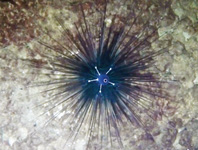Abstract
Diadema setosum (Leske, 1778), a widespread tropical echinoid and key herbivore in shallow water environments is currently expanding in the Mediterranean Sea. It was introduced by unknown means and first observed in southern Turkey in 2006. From there it spread eastwards to Lebanon (2009) and westwards to the Aegean Sea (2014). Since late 2016 sporadic sightings of black, long-spined sea urchins were reported by recreational divers from rock reefs off the Israeli coast. Numerous attempts to verify these records failed; neither did the BioBlitz Israel task force encounter any D. setosum in their campaigns. Finally, a single adult specimen was observed on June 17, 2017 in a deep rock crevice at 3.5 m depth at Gordon Beach, Tel Aviv. Although the specimen could not be recovered, spine fragments sampled were enough to genetically verify the visual underwater identification based on morphology. Sequences of COI, ATP8-Lysine, and the mitochondrial Control Region of the Israel specimen are identical to those of the specimen collected in 2006 in Turkey, unambiguously assigning the specimen to D. setosum clade b. This lends support to the hypothesis of a single introduction event and fits well with the habitat suitability and distribution model for D. setosum published recently. The more rapid and larger range extension along a south-eastern, counter-current trajectory may reflect a strong habitat preference for D. setosum in this area of the Levantine Basin as predicted by the model.
References
Arim, M., Abades, D.R., Neill, P.E., Lima M. & Marquet, P.A. (2006) Spread dynamics of invasive species. Proceedings of the National Academy of Sciences of the United States of America, 103, 374–378.
https://doi.org/10.1073/pnas.0504272102
Bauer, J.C. (1980) Observations on geographical variations in population density of the echinoid Diadema antillarum within the western North Atlantic. Bulletin of Marine Science, 30, 509–515.
Belmaker, J., Parravicini, V. & Kulbicki, M. (2013) Ecological traits and environmental affinity explain Red Sea fish introduction into the Mediterranean. Global Change Biology, 19, 1373–1382.
https://doi.org/10.1111/gcb.12132
Birkeland, C. (1989) The influence of echinoderms on coral-reef communities. In: Jangoux, M. & Lawrence, J.M. (Eds.), Echinoderm studies. Balkema, Rotterdam, pp. 1–79.
Bronstein, O. & Loya, Y. (2014) Echinoid community structure and rates of herbivory and bioerosion on exposed and sheltered reefs. Journal of Experimental Marine Biology and Ecology, 456, 8–17.
https://doi.org/10.1016/j.jembe.2014.03.003
Bronstein, O., Kroh, A. & Loya, Y. (2016) Reproduction of the long-spined sea urchin Diadema setosum in the Gulf of Aqaba—implications for the use of gonad-indexes. Scientific Reports, 6, 29569.
https://doi.org/10.1038/srep29569
Bronstein, O., Georgopoulou, E. & Kroh, A. (2017) On the distribution of the invasive long-spined echinoid Diadema setosum and its expansion in the Mediterranean Sea. Marine Ecology Progress Series, 583, 163–178.
https://doi.org/10.3354/meps12348
Bronstein, O., Kroh, A. & Haring, E. (2018) Mind the gap! The mitochondrial control region and its power as a phylogenetic marker in echinoids. BMC Evolutionary Biology, 18/1.
https://do.org/10.1186/s12862-018-1198-x
Byrnes, J.E., Reynolds, P.L. & Stachowicz, J.J. (2007) Invasions and Extinctions Reshape Coastal Marine Food Webs. PLoS ONE, 2, e295.
https://doi.org/10.1371/journal.pone.0000295
Coppard, S.E. & Campbell, A.C. (2004) Taxonomic significance of spine morphology in the echinoid genera Diadema and Echinothrix. Invertebrate Biology, 123, 357–371.
https://doi.org/10.1111/j.1744-7410.2004.tb00168.x
Edelist, D., Rilov, G., Golani, D., Carlton, J.T. & Spanier, E. (2013) Restructuring the Sea: profound shifts in the world's most invaded marine ecosystem. Diversity and Distributions, 19, 69–77.
https://doi.org/10.1111/ddi.12002
Galil, B.S. (2012) Truth and consequences: the bioinvasion of the Mediterranean Sea. Integrative Zoology, 7, 299–311.
https://doi.org/10.1111/j.1749-4877.2012.00307.x
Galil, B.S. & Goren, M. (2014) Metamorphoses: Bioinvasions in the Mediterranean Sea. In: Goffredo, S. & Dubinsky, Z. (Eds.), The Mediterranean Sea: Its history and present challenges. Springer Netherlands, Dordrecht, pp. 463–478.
https://doi.org/10.1007/978-94-007-6704-1_27
Golani, D. (2010) Colonization of the Mediterranean by Red Sea fishes via the Suez Canal – Lessepsian migration. In: Golani, D. & Appelbaum-Golani, B. (Eds.), Fish Invasions of the Mediterranean Sea: Changes and Renewal. Pensoft Publishers, Sofia-Moscow, pp. 145–188.
Lanfear, R., Frandsen, P.B., Wright, A.M., Senfeld, T. & Calcott, B. (2017) PartitionFinder 2: New Methods for Selecting Partitioned Models of Evolution for Molecular and Morphological Phylogenetic Analyses. Molecular Biology and Evolution, 34, 772–773.
Lawrence, J.M. & Sammarco, P.W. (1982) Effect of feeding on the environment: Echinoidea. In: Jangoux, M. & Lawrence, J.M. (Eds.) Echinoderm nutrition. A. A. Balkema Press, Rotterdam, pp. 499–519.
Leske, N.G. (1778) Jacobi Theodori Klein naturalis dispositio echinodermatum accessit lucubratiuncula De Aculeis Echinorum Marinorum cum spicilegio de belemnitis, edita et descriptionibus novisque inventis et synonomis auctorem aucta. Addimenta ad I. T. Klein naturalem dispositionem Echinodermatum. Schreiber, Thomas Johann, Leipzig, xxii+278 pp.
Lessios, H.A., Kessing, B.D. & Pearse, J.S. (2001) Population structure and speciation in tropical seas: global phylogeography of the sea urchin Diadema. Evolution, 55, 955–975.
https://doi.org/10.1111/j.0014-3820.2001.tb00613.x
Molnar, J.L., Gamboa, R.L., Revenga, C. & Spalding, M.D. (2008) Assessing the global threat of invasive species to marine biodiversity. Frontiers in Ecology and the Environment, 6, 485–492.
https://doi.org/10.1890/070064
Por, F.D. (1971) One Hundred Years of Suez Canal—A Century of Lessepsian Migration: Retrospect and Viewpoints. Systematic Biology, 20, 138–159.
https://doi.org/10.2307/2412054
Sala, E., Kizilkaya, Z., Yildirim, D. & Ballesteros, E. (2011) Alien Marine Fishes Deplete Algal Biomass in the Eastern Mediterranean. PLoS ONE, 6, e17356.
https://doi.org/10.1371/journal.pone.0017356
Schwarz, S. (1978) Estimating the Dimension of a Model. Annals of Statistics, 6, 461–464.
https://doi.org/10.1214/aos/1176344136
Walther, G-R., Roques, A., Hulme, P.E., Sykes, M.T., Pyšek, P., Kühn, I., Zobel, M., Bacher, S., Botta-Dukát, Z., Bugmann, H., Czúcz, B., Dauber, J., Hickler, T., Jarošík, V., Kenis, M., Klotz, S., Minchin, D., Moora, M., Nentwig, W., Ott, J., Panov, V.E., Reineking, B., Robinet, C., Semenchenko, V., Solarz, W., Thuiller, W., Vilà, M., Vohland, K. & Settele, J. (2009) Alien species in a warmer world: risks and opportunities. Trends in Ecology and Evolution, 24, 686–693.
https://doi.org/10.1016/j.tree.2009.06.008
Yahel, R. & Frid, O. (2018) Marine BioBlitz – Biological survey of Israels Mediterranean Marine Protected Areas The marine biodiversity. Final report Spring and Autumn 2015. Israel Nature and Parks Authority, Jerusalem, 56 pp.
Yokes, B. & Galil, B.S. (2006) The first record of the needle-spined urchin Diadema setosum (Leske, 1778) (Echinodermata: Echinoidea: Diadematidae) from the Mediterranean Sea. Aquatic Invasions, 1, 188–190.
https://doi.org/10.3391/ai.2006.1.3.15

